What is De-Dollarization? Exploring the Shift Away From the US Dollar’s Global Dominance

From the latter half of 2022 and persevering with into 2023, the idea of de-dollarization has gained vital traction, making its mark on the mainstream media. This surge in consideration will be attributed to the concerted efforts of BRICS nations reminiscent of Brazil, China, and Russia, who’re endeavoring to decrease the dominance of the dollar, stopping it from reclaiming its former place because the alpha foreign money. Although a prevailing sentiment means that the U.S. greenback’s world reserve standing is on the point of dissolution, there are dissenting voices asserting that the hype surrounding de-dollarization has been exaggerated.
Decoding De-Dollarization: Unraveling the Shift Away From the Greenback’s Global Hegemony
Two noteworthy topics have captured appreciable public curiosity as of late: the methods pursued by the BRICS nations (Brazil, Russia, India, China, and South Africa) and the idea of de-dollarization, which has emerged as a outstanding speaking level.
Although de-dollarization has garnered widespread protection within the mainstream media, there stays a big variety of people who lack a transparent understanding of its implications. The Visual Capitalist gives a comprehensive infographic on the U.S. greenback’s preliminary rise to being probably the most dominant, to the present de-dollarization pattern.
To start with, it’s broadly held that the U.S. greenback has served as the worldwide reserve foreign money for 78 years, ranging from the institution of the Bretton Woods Agreement in 1944. During World War I and World War II, the United States acquired gold funds from its allies, resulting in its emergence as the biggest world holder of gold at the moment.
However, the importance of this place diminished throughout the Nixon administration. A pivotal second got here when France found that the U.S. was printing extra money for the Vietnam War than it possessed in gold reserves. Consequently, in 1973, the petrodollar system was established, with Saudi Arabia agreeing to completely settle for U.S. {dollars} as cost for oil.
This association bolstered the dominance of the U.S. greenback for an extended period. However, the petrodollar’s power has been weakened since tensions between China and Russia emerged. In January 2023, Mohammed Al-Jadaan, the Finance Minister of Saudi Arabia, expressed openness to accepting currencies apart from the U.S. greenback in change for oil gross sales.
In a parallel improvement, the BRICS bloc has been implementing numerous strategic measures to conduct commerce utilizing native fiat currencies as an alternative of the dollar. Furthermore, BRICS nations have proven a eager curiosity in establishing a competing reserve currency to problem the dominance of the U.S. greenback. Collectively, these decisions signify the continued pattern of de-dollarization, reflecting a departure from the beforehand uncontested position of the U.S. greenback in world commerce and finance.
BRICS leaders are of the opinion that it’s possible to cut back the worldwide reliance on the U.S. greenback, a notion supported by numerous market observers. However, there are many skeptics who stay unconvinced concerning the vulnerability of the U.S. greenback. Despite the de-dollarization pattern, the International Monetary Fund (IMF) does not foresee a swift transition in U.S. greenback reserves.
Prominent American political scientist Ian Bremmer has dismissed the exaggerated claims of the greenback’s demise, whereas economist Paul Krugman has emphasized that the dollar will keep its presence for the foreseeable future.
De-dollarization basically signifies the diminishing or potential lack of the U.S. greenback’s standing as the worldwide reserve foreign money, carrying implications for the worldwide financial system and probably impacting numerous belongings and currencies.
In such a situation, central banks would possible have to intervene in overseas change (FX) markets, necessitating the institution of another reserve unit with ample liquidity for intervention functions. Data signifies the rising affect of different currencies, though the final word final result of the de-dollarization pattern stays unsure. Its true affect on the U.S. greenback’s dominance will solely be revealed over time.
Will the worldwide shift in direction of de-dollarization reshape the panorama of worldwide finance? Or do you suppose de-dollarization is a complete lot of scorching air? Share your ideas and opinions about this topic within the feedback part under.



